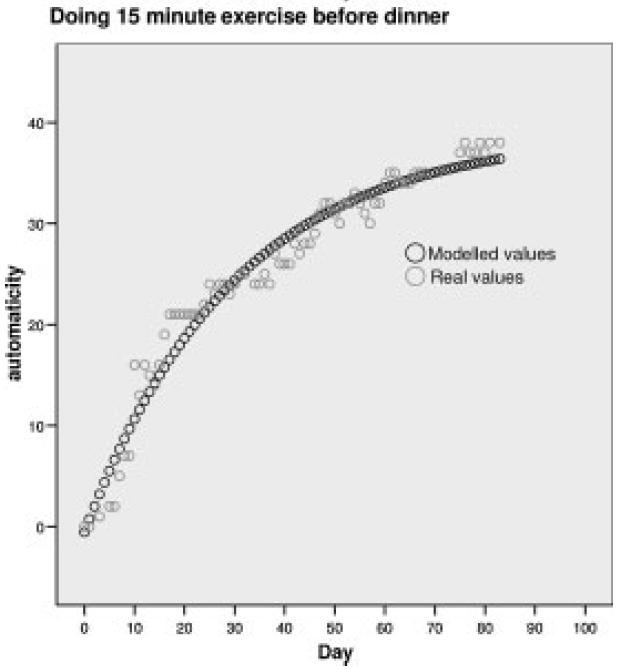
Example of increase in automaticity
Habit automaticity on desired new habits was measured daily
…participants were asked to choose a healthy eating, drinking or exercise behaviour that they would like to make into a habit. Participants were asked to try to carry out the behaviour every day for 84 days.
SRHI scores were the primary outcome measures… The behaviour of interest is followed by statements to which participants report their level of agreement; example items are ‘I do automatically’, ‘I do without thinking’ and ‘I would find hard not to do’. We created an automaticity subscale… which gave a total score range of 0–42.
Habit automaticity built fast at first, built slower later, and approached a maximum
…the relationship between repetition and habit strength follows an asymptotic curve in which automaticity increases steadily—but by a smaller amount with each repetition—until it reaches an asymptote (plateau).
SPSS Version 14 was used… to fit a curve for each individual’s data… using Mitscherlich’s law of diminishing returns (y=a-be-cx),
where
y is automaticity and
x is day of the study…
‘a’ represents the asymptote of the curve (the automaticity plateau score),
‘b’ is the difference between the asymptote and the modelled initial value of y (when x=0) and
‘c’ is the rate constant that represents the rate at which the maximum is reached.
- An asymptotic model proved to be a good fit for almost half (48%) of the participants who provided enough data for analysis.
- Those for whom the asymptotic model was a poor fit had typically carried out the behaviour fewer times during the study.
- Two other groups of participants had relatively high levels of performance; one for whom the model could not be fitted and one with a very high modelled asymptote. It is probable that these individuals were relatively slow in forming their habits and would have reached a plateau if the recording had continued for longer.
On average …the fit of the asymptotic curve was superior to the linear model. We are therefore reasonably confident that the asymptotic curve reflects a generalized habit formation process.
Habit automaticity plateaued only after very many repetitions
We were only able to find one statement in the literature discussing how long it takes to for a habit… once it has been ‘performed frequently (at least twice a month) and extensively (at least 10 times)’…
Our study has shown that it is likely to take much longer than this for a repeated behaviour to reach its maximum level of automaticity.
Early repetitions result in larger increases in automaticity than those later in the habit formation process, and there is a point at which the behaviour cannot become more automatic even with further repetition.
The average modelled time to plateau in this sample was 66 days, but the range was from 18 to 254 days.
Habit automaticity built better when repetitions were consistent
…even in this study where the participants were motivated to create habits, approximately half did not perform the behavior consistently enough to achieve habit status.
…missing one opportunity does not preclude habit formation, but missing a week’s worth of opportunities reduces the likelihood of future performance and hinders habit acquisition.
… individuals who performed the behaviour more consistently showed a change in automaticity scores which was modelled more closely by an asymptotic curve.
Habit automaticity required more repetitions for habits that were more complex
…it can take a large number of repetitions for an individual to reach their highest level of automaticity for some behaviours…
It is notable that the exercise group took one and a half times longer to reach their asymptote than the other two groups. Given that exercising can be considered more complex than eating or drinking, this supports the proposal that complexity of the behaviour impacts the development of automaticity.
…creating new habits will require self-control to be maintained for a significant period before the desired behaviours acquire the necessary automaticity to be performed without self-control.
…reaching a higher asymptote took longer.[1]
- Lally, Phillippa, et al. “How are habits formed: Modelling habit formation in the real world.” European journal of social psychology 40.6 (2010): 998-1009.